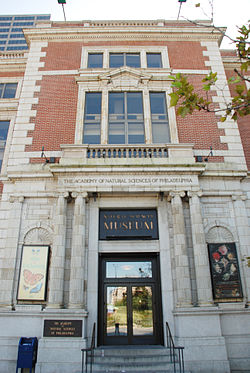The history of the Academy of Natural Sciences of Drexel University, the nation’s oldest natural history museum, mirrors the evolution of the relationship between the American people and the natural world. The Academy was founded when the United States hugged the Atlantic coastline, and Philadelphia was the cultural, commercial and scientific center of the new nation.
In early 19th-century Philadelphia, the collection and identification of natural specimens were popular activities. The New World, abundant with undiscovered plants and animals, provided a great deal of uncharted territory for anyone interested in exploring. In 1812, seven amateur naturalists formed a nucleus of resources with the hope of encouraging serious scholarly exchange as well as important scientific contributions to natural history. Initially meeting at one founder’s home, the founders created the Academy of Natural Sciences for “the encouragement and cultivation of the sciences and the advancement of useful learning.”
The Academy’s first home consisted of one room on the second floor of a house at Second and Race Streets. With eight books and a map of Switzerland, the group began a library, which currently holds hundreds of thousands of books, maps, manuscripts and artworks, and ranks among the world’s finest natural history libraries. Each founder also contributed a few specimens, initiating the Academy’s collections. Today those collections number more than 17 million specimens and include Thomas Jefferson's fossils, Lewis and Clark's plants, and many of the birds collected by John James Audubon.
Under the leadership of the new Academy, many new and developing disciplines put down their American roots — botany, entomology, geology, mineralogy, ichthyology, malacology, and paleontology. Early members included Thomas Say, a founder and "father” of both American entomology and conchology, Audubon, William Bartram, Alexander Wilson and Henry Muhlenberg. The Academy was the first American scientific organization to recognize the significance of Charles Darwin's research and elected him to associate membership in 1860.
Over the years, the Academy coordinated or participated in many explorations of uncharted territory, including Ferdinand Hayden’s expedition, which discovered what is now Yellowstone National Park and laid the foundation for the national park system. Through nearly 200 years of global exploration, which continues to this day, Academy researchers have studied living organisms and how they are affected by people. Their probing scientific inquiries and carefully documented research have propelled the Academy into the top echelons of research institutions.
Pages: 1 · 2
More Articles
- National Archives Records Lay Foundation for Killers of the Flower Moon: The Osage Murders and the Birth of the FBI
- Nichola D. Gutgold - The Most Private Roosevelt Makes a Significant Public Contribution: Ethel Carow Roosevelt Derby
- Ferida Wolff's Backyard: Turtles Sunbathing
- National Institutes of Health: Common Misconceptions About Vitamins and Minerals
- Oppenheimer: July 28 UC Berkeley Panel Discussion Focuses On The Man Behind The Movie
- Monetary Policy Report Prepared at the Federal Reserve Bank of Richmond, Expectations for Future Growth Were Mostly Unchanged
- Julia Sneden Wrote: Love Your Library
- Scientific Energy Breakeven: Advancements in National Defense and the Future of Clean Power
- The Beige Book Summary of Commentary on Current Economic Conditions By Federal Reserve District Wednesday November 30, 2022
- A la Frank Sinatra: "Come Fly With Me", U.S. Department of Transportation Airline Customer Service Dashboard







